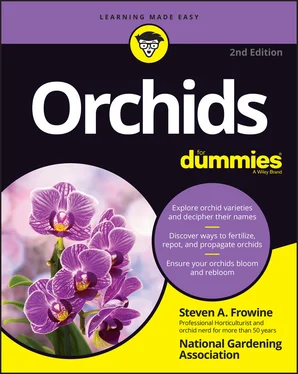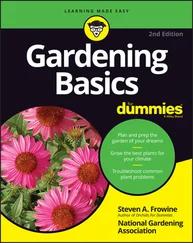9 Appendix A: Additional Orchid Resources Orchid Societies Online Resources Software Pronunciation Guide: How to Say the Most Common Orchid Names
10 Appendix B: English-Metric Conversion Tables
11 Index
12 About the Author
13 Supplemental Images
14 Advertisement Page
15 Connect with Dummies
16 End User License Agreement
1 Chapter 1 TABLE 1-1 Differences between Tulip and Orchid Flowers TABLE 1-2 The Components of a Species Orchid Name TABLE 1-3 The Components of a Hybrid Orchid’s Name
2 Chapter 2 TABLE 2-1 Orchid Temperature Preferences
3 Chapter 3 TABLE 3-1 Pros and Cons of Various Types of Labels TABLE 3-2 The Pros and Cons of Various Types of Label Markers
4 Chapter 5TABLE 5-1 Artificial Light SourcesTABLE 5-2 Comparing T5 Fluorescents and LEDs
5 Chapter 6TABLE 6-1 The Pros and Cons of Different Fertilizers and How to Use Them
6 Chapter 7TABLE 7-1 The Pros and Cons of Various Potting Materials
7 Chapter 9TABLE 9-1 Common Orchid Pests and Their Controls
8 Chapter 13TABLE 13-1 Oncidium Alliance Intergenerics
9 Appendix ATABLE A-1 Pronouncing Common Orchids
1 Chapter 1FIGURE 1-1: Comparing a cattleya flower with a tulip flower. FIGURE 1-2: Epiphytic orchids have thick roots covered with silver velamen. FIGURE 1-3: Terrestrial and semiterrestrial orchids, like most slipper orchids,...
2 Chapter 2FIGURE 2-1: Maximum-minimum thermometer. FIGURE 2-2: The shadow test is a simple and reasonably accurate way to measure ...FIGURE 2-3: An example of a handheld light meter.
3 Chapter 3FIGURE 3-1: Cutting tools — from left to right: thin-bladed knife, two pairs of...FIGURE 3-2: Potting tools — clockwise from top-left: rubber mallet, dibble, pot...FIGURE 3-3: This compact, lightweight, self-striking butane torch is a breeze t...FIGURE 3-4: A common type of water breaker. FIGURE 3-5: Thumb valves make watering easier. FIGURE 3-6: The most useful watering can is one with a long spout. FIGURE 3-7: Simple fertilizer injectors are easy to use and handy if you have q...
4 Chapter 4FIGURE 4-1: Staking flower spikes of spray-type orchids like phalaenopsis or on...FIGURE 4-2: Plastic plant clips attach the stem of the orchid to its stake, com...FIGURE 4-3: Trim off brown tips of leaves following the natural curvature of th...FIGURE 4-4: Placing plants on pedestals and inserting their growing pot inside ...FIGURE 4-5: This miniature arrangement contains only three small cattleya flowe...FIGURE 4-6: Wrapping the flower stem with florist’s wire. FIGURE 4-7: Wrap the flower stem with florist’s tape. FIGURE 4-8: Add a fern frond to the corsage. FIGURE 4-9: Add a ribbon and a florist’s pin.
5 Chapter 5FIGURE 5-1: The extent of the roof overhang has an influence in the amount of l...FIGURE 5-2: Bay windows increase the size of the growing area and the amount of...FIGURE 5-3: The type of leaf indicates an orchid’s light requirements. FIGURE 5-4: When orchids don’t receive enough light, their foliage tends to be ...FIGURE 5-5: A paphiopedilum leaf with a round or oval brown spot caused by too ...FIGURE 5-6: One of my off-the-shelf four-tube units with three tiers. FIGURE 5-7: An adjustable light fixture like this one is very handy for accommo...FIGURE 5-8: Approximate growing areas for different wattages of high-intensity-...FIGURE 5-9: An egg-crate louver set inside a waterproof tray. FIGURE 5-10: Ceiling fans can be set either to push warm air down (best for win...FIGURE 5-11: My shade house is an 8-foot (2.4-m) square simply constructed usin...FIGURE 5-12: Inside the shade house, plants are arranged on stepped-wire benche...FIGURE 5-13: An outdoor portable greenhouse can be an ideal place to put your o...FIGURE 5-14: Summer your orchids outdoors by using pot clamps to hang them from...
6 Chapter 6FIGURE 6-1: The pleated or puckered leaf of this miltonia orchid is a sign that...FIGURE 6-2: My orchid rescue, the place where I put orchids that have suffered ...FIGURE 6-3: The label on an orchid fertilizer reveals what the product contain...
7 Chapter 7FIGURE 7-1: You can find many different types of containers for growing orchids...FIGURE 7-2: When potting in a basket, line the basked with sheet moss, or sheet...FIGURE 7-3: New roots are emerging indicating it’s a good time to repot. FIGURE 7-4: Potting a sympodial orchid — this one a type of cattleya. FIGURE 7-5: Pot monopodial orchids in the center of the pot instead of at the b...
8 Chapter 8FIGURE 8-1: When dividing a cattleya, try to have at least three, or better fou...FIGURE 8-2: Making a drawing showing how a large orchid will be divided helps s...FIGURE 8-3: An orchid baby, or keiki, being removed from the mother plant and t...FIGURE 8-4: The three stages of topping an orchid. FIGURE 8-5: Producing more orchids from stem or cane cuttings. FIGURE 8-6: Growing new orchids from back bulbs.
9 Chapter 9FIGURE 9-1: Aphids are usually found in clusters on flower buds and young shoot...FIGURE 9-2: Mealybugs look like white cottony masses. FIGURE 9-3: Scale is a very common pest on orchids. FIGURE 9-4: Spider mites are very small, hard-to-see pests that can be very des...FIGURE 9-5: Snails and slugs eat holes in flowers and leaves at night. FIGURE 9-6: Leaf spots like these are usually caused by fungal organisms.
10 Chapter 10FIGURE 10-1: A close-up of the beautifully patterned leaf of Phalaenopsis stuar ...FIGURE 10-2: The parts of a moth orchid (phalaenopsis) flower. FIGURE 10-3: Phalaenopsis Cygnus ‘Renaissance.’ FIGURE 10-4: Candy-striped moth orchids like the Phalaenopsis Jackie Debonis ar...FIGURE 10-5: A harlequin-type of orchid, Phalaenopsis Sue Chin. FIGURE 10-6: One of the most popular of the fragrant moth orchids is Phalaenops ...FIGURE 10-7: Phalaenopsis bellina permeates any room it’s in. FIGURE 10-8: Phalaenopsis mannii is quite variable in its flower color. FIGURE 10-9: Phalaenopsis Sogo Twinkle is a compact gem that produces many char...FIGURE 10-10: Phalaenopsis mariae sports a colorful pattern of brown and red sp...
11 Chapter 11FIGURE 11-1: The structure of a typical cattleya flower (1 = Sepals; 2 = Petals...FIGURE 11-2: Cattleya harrisoniana has been a longtime favorite cattleya specie...FIGURE 11-3: Peru is proud to have the Cattleya maxima as its national flower. FIGURE 11-4: Laelia anceps bears its flowers on tall, elegant spikes. FIGURE 11-5: Brassavola nodosa is often recommended as a beginner’s orchid beca...FIGURE 11-6: Broughtonia sanguinea is a charmer native to Cuba and Jamaica. FIGURE 11-7: Prosthechea cochleata is recommended as an ideal beginner’s orchid...FIGURE 11-8: The claim to fame of the Prosthechea radiata is its sweet-scented ...FIGURE 11-9: Epidendrum ciliare has a spidery green flower with a delicate whit...FIGURE 11-10: Cattleya coccinea is a charming plant, but think again before buy...FIGURE 11-11: Cattlianthe Jewel Box ‘Scheherazade’ AM/AOS still remains a favor...FIGURE 11-12: Rhyncholaeliocattleya Goldenzelle ‘Lemon Chiffon’ AM/AOS is a gor...FIGURE 11-13: Rhyncholaeliocattleya Rio’s Green Magic offers unique beauty and ...FIGURE 11-14: Rhyncattleanthe Barana Beauty ‘Burana’ HCC/AOS offers clusters of...FIGURE 11-15: Rhyhncolaeliocattleya Hawaiian Avalanche provides a riot of color...FIGURE 11-16: Cattleya luteola is a cutie with a fresh floral scent that is str...FIGURE 11-17: Brassocattleya Binosa ‘Kirk’ AMAOS combines a sweet scent with a ...FIGURE 11-18 Cattleya Peckhaviensis shows its spots and bright magenta lip from...FIGURE 11-19 Laeliocattleya Angel Love is a perfectly shaped dwarf cattleya wit...
Читать дальше












